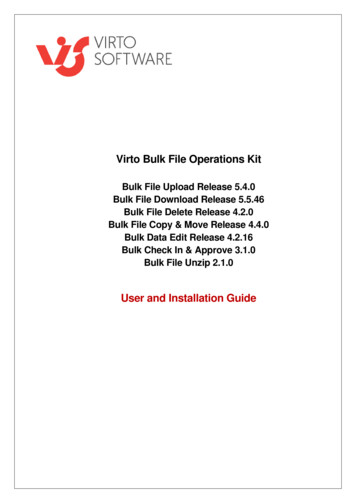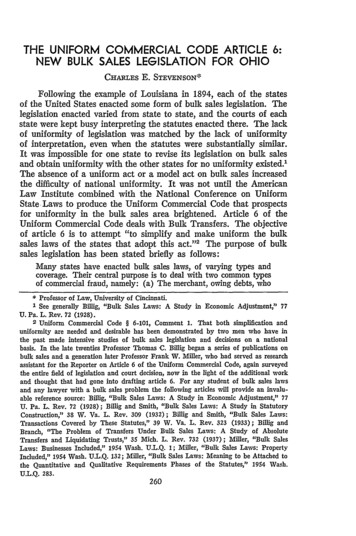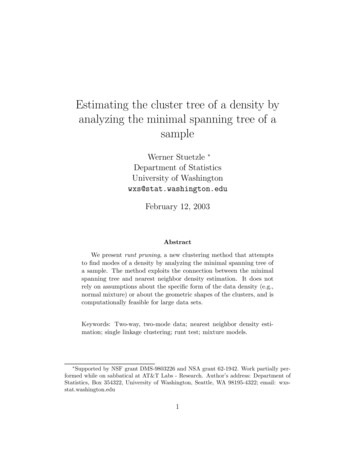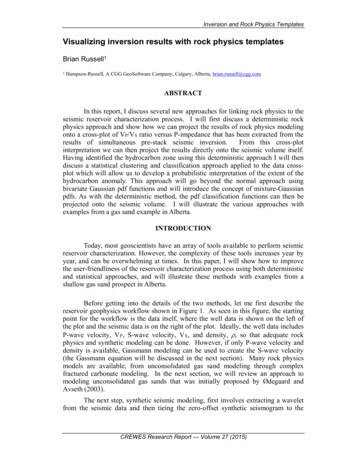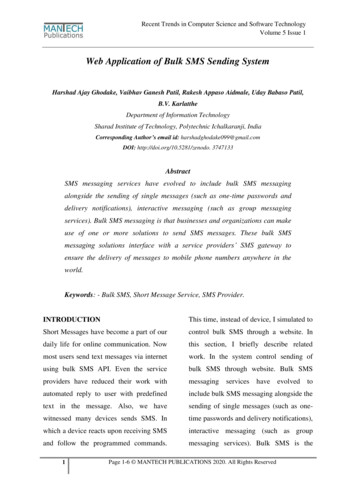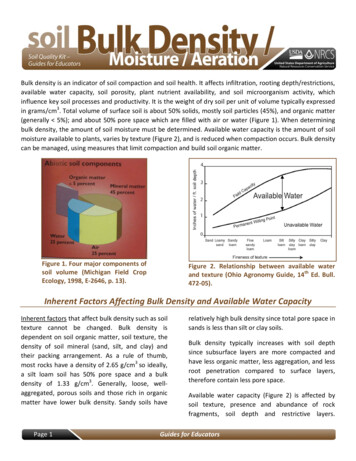
Transcription
Bulk density is an indicator of soil compaction and soil health. It affects infiltration, rooting depth/restrictions,available water capacity, soil porosity, plant nutrient availability, and soil microorganism activity, whichinfluence key soil processes and productivity. It is the weight of dry soil per unit of volume typically expressedin grams/cm3. Total volume of surface soil is about 50% solids, mostly soil particles (45%), and organic matter(generally 5%); and about 50% pore space which are filled with air or water (Figure 1). When determiningbulk density, the amount of soil moisture must be determined. Available water capacity is the amount of soilmoisture available to plants, varies by texture (Figure 2), and is reduced when compaction occurs. Bulk densitycan be managed, using measures that limit compaction and build soil organic matter.Figure 1. Four major components ofsoil volume (Michigan Field CropEcology, 1998, E-2646, p. 13).Figure 2. Relationship between available waterand texture (Ohio Agronomy Guide, 14th Ed. Bull.472-05).Inherent Factors Affecting Bulk Density and Available Water CapacityInherent factors that affect bulk density such as soiltexture cannot be changed. Bulk density isdependent on soil organic matter, soil texture, thedensity of soil mineral (sand, silt, and clay) andtheir packing arrangement. As a rule of thumb,most rocks have a density of 2.65 g/cm3 so ideally,a silt loam soil has 50% pore space and a bulkdensity of 1.33 g/cm3. Generally, loose, wellaggregated, porous soils and those rich in organicmatter have lower bulk density. Sandy soils havePage 1relatively high bulk density since total pore space insands is less than silt or clay soils.Bulk density typically increases with soil depthsince subsurface layers are more compacted andhave less organic matter, less aggregation, and lessroot penetration compared to surface layers,therefore contain less pore space.Available water capacity (Figure 2) is affected bysoil texture, presence and abundance of rockfragments, soil depth and restrictive layers.Guides for Educators
Soil Bulk Density / Moisture / Aeration – Soil Quality KitUSDA-NRCSBulk Density ManagementBulk density can be changed by managementpractices that affect soil cover, organic matter, soilstructure, compaction, and porosity. Excessivetillage destroys soil organic matter and weakensthe natural stability of soil aggregates making themsusceptible to erosion caused by water and wind.When eroded soil particles fill pore space, porosityis reduced and bulk density increases. Tillage andequipment travel results in compacted soil layerswith increased bulk density, most notably a “plowpan” (Figures 3 and 4). Tillage prior to plantingtemporarily decreases bulk density on the surfacebut increases at the depth of tillage. Subsequenttrips across the field by farm equipment, rainfallevents, animals, and other disturbance activitieswill also compact soil. Long-term solutions to soilcompaction center on decreasing soil disturbanceand increasing soil organic matter. Subsoil to disrupt existing compacted layers; and Use multi-crop systems involving plants withdifferent rooting depths to help break upcompacted soil layers.Compacted inter-row restrictsroots, worms, aeration, andN availability.Figure 3. Compacted soil in wheeltraffic row.A soil’s available water capacity is also affected byorganic matter and compaction. Organic matterincreases a soil’s ability to hold water, both directlyand indirectly. Compaction increases bulk densityand reduces total pore volume, consequentlyreducing available water holding capacity.The following measures increase organic matter,and reduce compaction, which improve bulkdensity and porosity: Practices that increase organic matter such ascontinuous no-till, cover crops, solid manure orcompost application, diverse rotations with highresidue crops and perennial legumes or grassused in rotation; Minimize soil disturbance and avoid operatingequipment when soils are wet; Use designated roads or rows for equipment; Reduce the number of trips across a field;Page 2Figure 4. Compacted plow layer inhibiting rootpenetration and water movement through soilprofile (adapted from: The Nature and Propertiesof Soils, 10th Edition).Guides for Educators
Soil Bulk Density / Moisture / Aeration – Soil Quality KitWater-Filled Pore Space and PorosityWhen determining bulk density, water-filled porespace and porosity can also be calculated. Whenwater-filled pore space exceeds 60%, severalimportant soil processes are impacted. Soilrespiration and nitrogen cycling (ammonificationand nitrification) increase with increasing soilmoisture (Figure 5). Lack of aeration also interfereswith a soil organism’s ability to respire and cyclenitrogen. In dry soils, these processes declinebecause of lack of soil moisture.As soil water-filled pore space exceeds 80%, soilrespiration declines to a minimum level anddenitrification occurs resulting in loss of nitrogen asUSDA-NRCSgas, emission of potent greenhouse gases, yieldreduction, and/or increased N fertilizer expense.Figure 5. Relationship of water-filled pore space tosoil microbial activity (Linn and Doran, 1984).Soil Bulk Density Problems and Relationship to Soil FunctionHigh bulk density is an indicator of low soil porosityand soil compaction. High bulk density impactsavailable water capacity, root growth, andmovement of air and water through soil.Compaction increases bulk density and reducescrop yields and vegetative cover available toprotect soil from erosion. By reducing waterinfiltration into soil, compaction can lead toincrease runoff and erosion from sloping land orsaturated soils in flatter areas. Bulk densities abovethresholds in Table 1 impair root growth.Laboratory analyses should use bulk density toadjust volume of soil to determine organic matterand nutrient content of soil. For example, a soilwith a bulk density of 1.3 versus a soil with a bulkdensity of 1.0 would result in a 30% error in organicmatter and nutrient content if the samples are notadjusted for bulk density.Table 1. General relationship of soil bulk density to root growth based on soil texture.Soil TextureSands, loamy sandsSandy loams, loamsSandy clay loams, clay loamsSilts, silt loamsSilt loams, silty clay loamsSandy clays, silty clays, clay loamsClays ( 45% clay)Page 3Ideal bulk densitiesfor plant growth(grams/cm3) 1.60 1.40 1.40 1.40 1.40 1.10 1.10Bulk densities thataffect root s for EducatorsBulk densities thatrestrict root growth(grams/cm3) 1.80 1.80 1.75 1.75 1.65 1.58 1.47
Soil Bulk Density / Moisture / Aeration – Soil Quality KitUSDA-NRCSWhat management measures and practices do you think affect bulk density? Why or why not?What impact do you expect these practices on organic matter and soil porosity?Measuring Bulk Density and Soil Moisturelocation as infiltration and respiration tests. It maybe possible to use the infiltration test sample. Forsticky clay soils a little penetrating oil applied to thering makes it easier to remove soil.Materials Needed to Measure Bulk Density3-inch diameter aluminum ringWood block or plastic insertion capStep by Step ProcedureRubber mallet or weight1. Carefully clear all residue then drive ring to adepth of 3 inches (2 inches from top; seeFigures 6 and 7) with small mallet or weight andblock of wood or plastic cap (same process asused for infiltration test).Folding trowelFlat-bladed knifeSealable bags and marker penScale (1 g precision)1/8 cup (29.5 mL) measuring scoopCeramic coffee cup or paper plate18-inch metal rod, probe or spade (to checkfor compaction zone)Access to a microwave ovenFigure 6. Drive ring to 3-inch depth.Considerations – Bulk density can be measured atthe soil surface and/or compacted tillage zone.Bulk density samples should be taken in samePage 4Guides for Educators
Soil Bulk Density / Moisture / Aeration – Soil Quality KitUSDA-NRCS6. Weigh an identical clean, empty plastic bag andrecord its weight in Table 2.7. Weigh empty cup or paper plate to be used instep 8 and record its weight on Table 2.8. Either extract a subsample shown in steps 8-10,or dry and weigh entire sample to determinewater content and dry soil weight:Figure 7. Ring driven to 3-inch depth.2. Remove ring by cutting around the outsideedge with a small 4-inch serrated butter knifeand using the small folding trowel underneathof it and carefully lift the ring out preventingloss of soil by holding trowel under it.3. Remove excess soil from the bottom of cylinderwith serrated butter knife as shown in Figure 8.a. Mix sample thoroughly in the bag bykneading it with your fingers.b. Take a 1/8-cup level scoop of loose soil (notpacked down) from plastic bag and place itin the cup weighed in step 7 (use more thanone scoop to increase accuracy).9. Weigh moist subsample in cup before dryingand record in table 2.10. Place cup containing subsample in a microwave and dry for two or more four-minutecycles at medium power.Figure 8. Remove excess soilfrom bottom of ring.4. Place sample in plastic sealable bag and label it.11. To determine if soil is dry, weigh subsample incup/plate after each 4-minute cycle. When theweight no longer changes after a drying cycle, itis dry, and record its weight on Table 2.5. Weigh sample in bag and record its weight inTable 2.InterpretationsComplete Table 2 for bulk density and soil watercontent determination and compare results to thesame soil texture listed in Table 1 to determinerelative restrictions to root growth or compactionconcerns. Complete Tables 3 through 5 for soilwater and porosity determination and comparePage 5results to Figure 5. relationship of water-filled porespace to soil organism’s ability to respire and cyclenitrogen Figure 2. water content. Answerdiscussion questions to further analyze yourresults.Guides for Educators
Soil Bulk Density / Moisture / Aeration – Soil Quality KitUSDA-NRCSTable 2. Bulk density and soil water content (core method). Refer to calculations below for details.Sample site(a)Wt of fieldmoist soil sample bag(grams)(entiresample)Ex. 1490 g(b)(c)Wt ofWt ofsample cupbag(grams)(grams)5g126 g(d)Wt of cup moist soil(grams)(subsample)(e)Wt ofmoistsoil(grams)(d-c)(f)Wt ofdrysoil cup(grams)(g)Dry Wtof soil(grams)(f-c)(h)Soil H2Ocontent(grams/gram)(d - e)/(g)(i)*Soilbulkdensity(g/cm3)160 g34 g153 g27 g0.259 g/g1.2g/cm3*Soil bulk density [(a - b)/(1 h)] volume of soil core (Volume of soil core 321 cm3 for 3" core, 2" fromtop of soil to top of ring, refer to Figure 11 and volume calculations below)Abbreviations for Example 1 (Wt Weight; π 3.14; g grams; r radius of inside diameter of ring/core)Volume of Soil Core (cm3) (refer to Figure 11)Example 1 (refer to Figure 11)πr2 x height3.14 x (3.66 cm)2 x (7.62 cm) 321 cm3Soil Water Content Using a Subsample (g/g)Example 1 (e - g)/(g)(weight of moist soil - weight of oven dry soil)Weight of oven dry soil(34g – 27g) 0.259 g of water/g of soil27gCalculating the Dry Weight of the Bulk Sample Based on Soil Water Content of Subsample (grams)Dry wt of soil bulk sample [Wt of field moist soil bag (grams) - Wt of bag (grams)][1 Soil Water content (g/g)]Example 1: dry wt of bulk sample [(a - b)/(1 h)] (490 g - 5 g) 385 g(1 .259)Bulk Density Calculation (g/cm3)Bulk Density Dry wt of bulk sample volume of soil coreExample 1: bulk density 385g 321 cm3 1.20 g/cm3Page 6Guides for Educators
Soil Bulk Density / Moisture / Aeration – Soil Quality KitUSDA-NRCSSoil Water Content and Porosity CalculationsTable 3. Soil water content.Sample SiteExample 1Soil Water Content (byWt) (g/g) (from h in Table2)0.259Bulk density(g/cm3) from Table21.2 g/cm3* Volumetricwater content(g/cm3)0.3108 g/cm3** Inches ofwater/ft. of soildepth3.7"/ft* Volumetric water content (g/cm3) soil water content (g/g) x bulk density (g/cm3)** Inches of water/ft. of soil depth volumetric water content x 12"/ftTable 4. Soil porosity (%).Sample SiteExample 1Bulk Density(grams/cm3) from Table21.2grams/cm3Calculation1 - (soil bulk density /2.65)1 - (1.2/2.65)* Soil porosity (%)0.547 or 54.7%* Soil porosity (%) 1 - (soil bulk density / 2.65). The default value of 2.65 is used as a rule ofthumb based on the average bulk density of rock with no pore space.Table 5. Soil water filled pore space (%).SampleSiteEx. 1Volumetric watercontent(grams/cm3) fromTable 30.3108 grams/cm3Soil porosityfrom Table 4Volumetric WaterContent / Soil porosity x100* Soil WaterFilled PoreSpace0.5470.3108 g/cm3 / .547 x 100.568 or 56.8%* Soil water-filled pore space (%) (volumetric water content / soil porosity) x 100Page 7Guides for Educators
Soil Bulk Density / Moisture / Aeration – Soil Quality KitUSDA-NRCSBlack(Pore space)Volume 3321 cmWhite(Soil particles)TotalWeight 485 gFigure 9. Soil porosity.Solids45.3%Water31.1%Total Pore Space 54.7%(56.8 % water filled and43.2% air filled pores)Air23.6%Figure 11. Soil core dimensions, volume,and weight (by component) Example 1.Figure 10. Volume by component of Example 1 soilcore (volume 321 cm3).Were results of bulk density and porosity tests what you expected? Why or why not?Compare results of water-filled pore space calculation to Figure 5. Is soil organism’s ability to respire andcycle nitrogen impacted? If so what impact on production may occur and are these processes water oraeration limited?Page 8Guides for Educators
Soil Bulk Density / Moisture / Aeration – Soil Quality KitUSDA-NRCSCompare bulk density results to values in Table 1 for the same soil texture on this field. Are bulk densitieslevels ideal based on the soil texture? Why or why not?Compare total water content (inches/ft soil depth) from Table 3 to available water capacity (AWC) shown inFigure 2 for the same texture. Is soil near field capacity?GlossaryAmmonification – Occurs in nitrogen cycle whensoil organisms decompose organic-nitrogenconverting it to ammonia.Available Water Holding Capacity – Soil moistureavailable for crop growth (Figure 1). It is alsodefined as the difference between field capacityand wilting point, typically shown in inches/ft.Nitrification – Occurs in nitrogen cycle when soilorganisms convert ammonia and ammonium intonitrite and next to nitrate-nitrogen which isavailable to plants.Bulk Density – Weight of dry soil per unit ofvolume, more compacted soil with less pore spacewill have a higher bulk density.Respiration – Carbon dioxide (CO2) release fromsoil from several sources: decomposition of organicmatter by soil microbes, respiration from plantroots and soil fauna (requires oxygen; aerobes).Soil Porosity – Percent of total soil volume madeup of pore space (Figure 4).Soil Water Filled Pore Space – Percent of porespace filled with water.Soil Water Content, Gravimetric – Weight of soilwater per unit of dry soil weight.Volumetric Water Content – Amount (weight orvolume) of water in soil core by volume. (1 g water 1 cm3).Denitrification – Conversion and loss of nitratenitrogen as nitrogen gases when soil becomessaturated with water.USDA is an equal opportunity provider and employer.Page 9Guides for Educators
6. Weigh an identical clean, empty plastic bag and record its weight in Table 2. 7. Weigh empty cupor paper plate to be used in step 8 and record its weight on Table 2. 8. Either extract a subsample shown in steps 8-10, or dry and weigh entire sample to determine water content and dry soil weight: a. Mix sample thoroughly in the bag by
